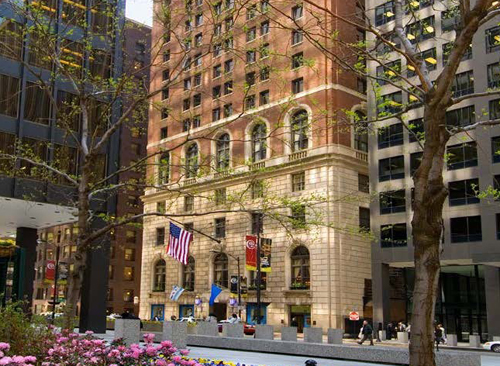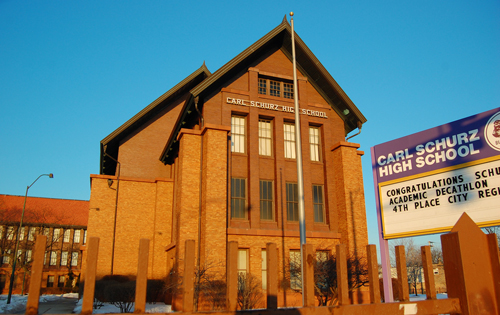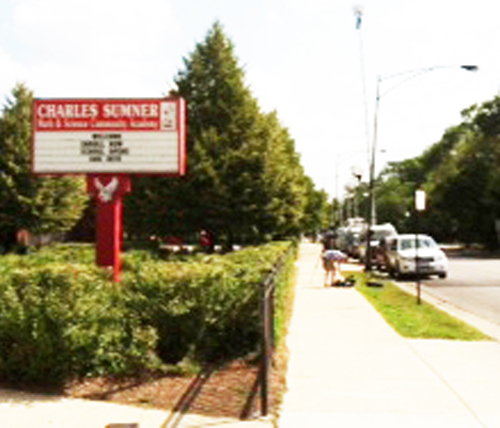Chicago home of the 'Union League' was never going to name schools or parks or other public places after the defenders of slavery and secession...Dozens of Chicago schools, parks, and communities are named after heroes of the fight to end slavery and begin the Freedom Road to freedom...
 Although Chicago's Union League Club (above, on Jackson Blvd in the Loop) is in 2017 a well regarded hotel and party venue (many weddings are held there), the history of the Union League is rooted in the years following the Civil War. Chicago was one of the strongest places for support for the Union during the Civil War, and as a result, following the Civil War the Union League helped establish many Chicago policies. One of those was that no Chicago school was to be named after any slave-owning secessionist. Even Chicago's Lee Elementary School is not names after Robert E. Lee, but another Lee. Dozens of Chicago's elementary and high schools were named after prominent Civil War Union generals, and entire communities (e.g., Logan Square) were also named after Civil War heroes.Most Chicagoans have never looked closely at the naming of Chicago's public schools or parks, but as the controversies over the residue of slavey continue to rumble across the USA it's important to note that Chicago never named a school after any of the defenders of slavery. Even Chicago's "Lee Elementary School" (6448 S. Tripp Avenue, Chicago, IL 60629) has nothing to do with Robert E. Lee, the odious slave owner who led Confederate armies and allowed the massacre of captured African American Union soldiers.
Although Chicago's Union League Club (above, on Jackson Blvd in the Loop) is in 2017 a well regarded hotel and party venue (many weddings are held there), the history of the Union League is rooted in the years following the Civil War. Chicago was one of the strongest places for support for the Union during the Civil War, and as a result, following the Civil War the Union League helped establish many Chicago policies. One of those was that no Chicago school was to be named after any slave-owning secessionist. Even Chicago's Lee Elementary School is not names after Robert E. Lee, but another Lee. Dozens of Chicago's elementary and high schools were named after prominent Civil War Union generals, and entire communities (e.g., Logan Square) were also named after Civil War heroes.Most Chicagoans have never looked closely at the naming of Chicago's public schools or parks, but as the controversies over the residue of slavey continue to rumble across the USA it's important to note that Chicago never named a school after any of the defenders of slavery. Even Chicago's "Lee Elementary School" (6448 S. Tripp Avenue, Chicago, IL 60629) has nothing to do with Robert E. Lee, the odious slave owner who led Confederate armies and allowed the massacre of captured African American Union soldiers.
Even with careful searching, Chicago's news media has only been able to find one monument to anything Confederate -- and that is in a private cemetery. The large monument is to Confederate POWs, who died, mostly from disease, while imprisoned in a camp on the South Side. They died because the Confederate government was unwilling to "parole" them (a term at the time which meant that they would be released on condition that they would not return to fight).
Monuments to the victorious Union fight against the slaveocracy are everywhere in Chicago, however, beginning with the impressive Union League Club building in the Loop.
The importance of the Union League in the years after the defeat of the Confederacy i underscored in a powerful recent movie, "The Free State of Jones."
"Union League! Union League!" is a chant that has been revived, at least for some, with the historical film "The Free State of Jones." As the movie shows, the Union League became the first hope of former slaves for freedom and democracy following the Civil War (a hope that was bashed by the organization of the first and largest white supremacist terrorist group in the USA -- the Ku Klux Klan -- during the latter years of the 19th Century).
Chicago's Union League Club still stands as a reminder of the contribution of Chicago to the cause of freedom at that time. At the same time, the Confederate memorials across the USA stand -- less so today -- a monuments to the "lost cause" of the secessionists in defense of chattel slavery. A correction in the history books was necessary after nearly a century of racist historiography misled entire generations of Americans via a also version if history. (Among those racist historians was Woodrow Wilson, who was a historian before he became President of the United States and instituted some of the most vicious Jim Crow laws in history).
Just about every major Civil War general who fought on the Union side was eventually given recognition in Chicago with a monument, a school, or some other venue named after him. Among those who were prominent were Ulysses S. Grant (Grant Elementary School, now Phoenix Military Academy High School), William T. Sherman (currently, the "Sherman School of Excellence"), George W. Thomas (the school building was sold and is now condos, but the name is still in the masonry work; and Philip Sheridan Elementary School (which had its named changed by Mayor Richard M. Daley to the Arnold Mireles Elementary School in 1998). Dozens of other Chicago schools are named after those who helped lead the Union to victory over slavery in the Civil War.
 Carl Schurz High School, at the corner of Addison and Milwaukee Ave. on Chicago's northwest side, is named in honor of one of the leaders of the fight against slavery in the U.S. Congress during the years before, during and after the Civil War.Prominent civilian leaders are also honored: Lincoln Park (along with Lincoln Elementary School and Lincoln Park High School) is one of the most prominent. But others include Carl Schurz High School (whose library includes a beautiful mural to freedom) and others. Before it was closed down, Washburn Trade School's name honored the memory of Eliu Washburn, the Illinois political leader who got U.S. Grant his commission when Grant returned to military service in 1861.
Carl Schurz High School, at the corner of Addison and Milwaukee Ave. on Chicago's northwest side, is named in honor of one of the leaders of the fight against slavery in the U.S. Congress during the years before, during and after the Civil War.Prominent civilian leaders are also honored: Lincoln Park (along with Lincoln Elementary School and Lincoln Park High School) is one of the most prominent. But others include Carl Schurz High School (whose library includes a beautiful mural to freedom) and others. Before it was closed down, Washburn Trade School's name honored the memory of Eliu Washburn, the Illinois political leader who got U.S. Grant his commission when Grant returned to military service in 1861.
Chicago's school remind us of the memory of both the military and civilian leaders who led the fight to save the United States of America and to provide real freedom to the five million former slaves who were liberated by the Union armies from the Ohio Valley to the Florida Keys. But as current events show, the battles to define the facts of history and to tell the stories of freedom continue. In a way, the most monstrous "alternative facts" supported by the current administration of Donald Trump became official U.S. History after the defeat of Radical Reconstruction and the rise of Jim Crow in the late 19th Century. The legacy of those lies continues to this day.
 Sumner Elementary School -- currently "Sumner Math and Science Academy" -- is named after the courageous Massachusetts abolitionist and Senator Charles Sumner. Charles Sumner was one of the leaders of radical reconstruction that attempted to secure rights for former slaves in the years immediately following the Civil War. The "Charles Sumner Math and Science Academy", a Chicago elementary school, is located on Chicago's west side. It is named after the famous anti-slavery orator and political leader Charles Sumner, who at one point was attacked in the U.S. Senate for an anti slavery speech. Sumner was one of the architects of Reconstruction, under which former slaves were protected against the attacks by the growing KKK across the South, which was occupied until 1876 by federal troops. The withdrawal of the Union Army from the former confederacy marks the beginning of the reign of domestic terrorism that led to the era of "Jim Crow". Jim Crow, which became the policy of the state and eventually the federal government (after Woodrow Wilson segregated federal jobs) was only broken up by the federal government and the Civil Rights Movement in the 1960s.
Sumner Elementary School -- currently "Sumner Math and Science Academy" -- is named after the courageous Massachusetts abolitionist and Senator Charles Sumner. Charles Sumner was one of the leaders of radical reconstruction that attempted to secure rights for former slaves in the years immediately following the Civil War. The "Charles Sumner Math and Science Academy", a Chicago elementary school, is located on Chicago's west side. It is named after the famous anti-slavery orator and political leader Charles Sumner, who at one point was attacked in the U.S. Senate for an anti slavery speech. Sumner was one of the architects of Reconstruction, under which former slaves were protected against the attacks by the growing KKK across the South, which was occupied until 1876 by federal troops. The withdrawal of the Union Army from the former confederacy marks the beginning of the reign of domestic terrorism that led to the era of "Jim Crow". Jim Crow, which became the policy of the state and eventually the federal government (after Woodrow Wilson segregated federal jobs) was only broken up by the federal government and the Civil Rights Movement in the 1960s.
In fact, Chicago public school students could learn a lot about the true history of the victory over slavery via a tour of present and former schools, one that could begin at the Union League Club on W. Jackson Blvd. in the Loop.
CHICAGO TRIBUNE STORY ABOUT A CONFEDERATE MONUMENT IN A PRIVATE CHICAGO CEMETERY...
Confederate monument stands on Chicago's South Side as questions swirl around the country
Chicago Tribune, August 17, 2017
While a national debate over Confederate symbols in the U.S. rages this week, a monument on Chicago's South Side commemorating the deaths of 4,000 Confederate soldiers stands largely unnoticed.
At Oak Woods Cemetery in the Grand Crossing neighborhood, the 30-foot granite monument, called Confederate Mound, marks the mass grave of soldiers captured and held at Camp Douglas, where many died of smallpox and cholera.
Topped by a bronze statue of a Confederate infantry soldier, arms folded across his chest, the monument was dedicated in 1895, with President Grover Cleveland and an estimated 100,000 people attending.
Unlike many other statues commemorating the Confederacy, this monument's placement in a private cemetery puts it alongside some of the nation's most prominent African-Americans, including anti-lynching crusader Ida B. Wells, Olympic hero Jesse Owens, gospel music pioneer Thomas Dorsey and Chicago's first black mayor, Harold Washington.
The Rev. James Dukes, of Liberation Christian Center, a South Side church, said that juxtaposition is a "healthy example" of how people should recognize "a past that is long passed."
"We can't erase the Civil War. We can't erase the fact that there was a Confederacy and a Union," he said. "But at the same time, those type of monuments acknowledge the fact that Harold Washington could become the mayor of Chicago because of the victory that took place over the Confederacy."
"I don't see it as a contradiction or a disrespect," Dukes said.
Instead, the monument should serve as a reflection of what black Americans went through during the Civil War and the Jim Crow era, he said.
However, while the monument is relatively obscure, its ornate nature and its origins may raise questions about its appropriateness, one historian said.
“If you want to mark the people who died in battle and to recognize and memorialize them. But the question then becomes ... is this a memorial to the Confederacy? It's not like the Robert E. Lee statue in that it's marking people who died in war," said Ann Keating, history professor at North Central College in Naperville and co-editor of "Encyclopedia of Chicago."
"But (the soldiers are) there because of questions regarding slavery and equal rights for all people," she said.
Many Confederate monuments were put up during the Jim Crow era to intimidate blacks, Keating said, but this monument, while paid for initially with private funds, had the support of the federal government to encourage reconciliation between white people from the Confederacy and the Union.
"White men — North and South — were united by their support of segregation. They abandoned the whole issue of racial equality as one of the key things that was supposed to come out of the war," she said. "In that sense, this monument is troubling."
Timuel Black, an educator, activist and longtime South Side resident, said few black Chicagoans are aware that the monument exists because for many years, black Americans were largely restricted from being buried in Oak Woods Cemetery.
"It's a story that needs to be told. Most people, regardless of their background, couldn't imagine that a Confederate monument in the North continues to exist," Black said.
"Most blacks throughout my period — I've been in Chicago for more than 90 years — just didn't know that monument was there.
"If they'd known it was there and that they were segregated at the same time, they would have caused some trouble. They would have demonstrated in opposition of the monument being there. Of that, I'm pretty certain of because I would have been a part of it," he said.
The monument did garner some heat from black Chicago City Council members in 1992, when efforts to designate a historical landmark at the site failed. Black aldermen, led by Allan Streeter, threatened to stage a public fight against the designation on the grounds that it would honor soldiers who fought to preserve slavery.
While Oak Woods is known as a place of remembrance for famous black Americans, other luminaries also are buried there, such as nuclear physicist Enrico Fermi and the first baseball commissioner, Kenesaw Mountain Landis.
The cemetery was in the news in 2008, when disgraced Gov. Rod Blagojevich named Roland Burris to fill Barack Obama's Senate seat. Burris was the subject of ridicule because he had already built a mausoleum for himself at Oak Woods with the words "TRAIL BLAZER" atop a list of accomplishments.
The Rev. Jesse Jackson said he hasn't seen the Confederate monument but said he'd like to look into it.
"Confederate statues represent the unfinished business of American history," he said. "These guys were traitors to our country. The abolitionists — those who saved the Union and ended slavery — should be glorified."
nmoreno@chicagotribune.com
Comments:
By: Ed Hershey
Fuller Elementary
Steve Bogira noted in a 2013 cover story for the Reader the story behind Fuller Elementary. Fuller is named for an Illinois segregationist:
On June 15, 1863—exactly 150 years ago this coming Saturday—a "Colored School" opened in Chicago. The city's black residents hadn't asked for it.
Six months earlier, a state representative from Chicago named Melville Fuller had proposed that Chicago be required to provide a separate school for Negro and mulatto children, and prohibited from allowing "colored" children to attend schools with whites. The bill soon passed and was signed into law, the City Council and the Board of Education quickly complied, and the Colored School opened in a building rented from a church. The Chicago Times exulted that the city's white children would henceforth be spared "the degrading necessity of associating with the negro."
Black parents held mass meetings and wrote letters to newspapers protesting the school. Segregated education was "uncharitable in its purpose," they said, and designed to "retard the moral and intellectual progress" of Negro youth. The General Assembly repealed the separate-school law two years later. It's not clear whether this was due mainly to the pressure from black parents or to the Union's triumph in the Civil War.
A century and a half later, Chicago does not have a separate school for black children, of course. It has scores of them. Forty-one percent of the city's public schools—277 of 681—are at least 90 percent black. Sixty-eight percent of the black students enrolled in the Chicago Public Schools are in these schools. The vast majority of these students are from low-income families; many are living below the poverty line. Non-Hispanic whites account for 32 percent of the city's population, but only 9 percent of CPS's enrollment.
Melville Fuller went on to become chief justice of the U.S. Supreme Court in 1888, and three years later, a south-side elementary school was named in his honor. Today, the school named for the sponsor of the Colored School law is 98 percent black.
https://www.chicagoreader.com/chicago/segregated-schools-desegregation-city-suburbs-history-solutions/Content?oid=9992386
By: Jim Vail
Great Story!
Good to know we do have some history we can be proud of. Thanks George.


By: Bob Busch
Tour
It might seem strange to go on a field trip to a cemetery,take one to Oak Woods.We had a guide get on the bus as we toured the grounds.Not only are the grounds beautiful, but those buried there read like a history book.But kids are kids and more got off the bus to visit the graves of Flukey Stokes,and his son Willie the Whimp, as did to visit Harold Washington's.Everyone looked over the Confederate monument.